A Stochastic Inexact Robust Model for Regional Energy System Management and Emission Reduction Potential Analysis—A Case Study of Zibo City, China
Abstract
:1. Introduction
2. Methodology
2.1. Inexact Scenario-Based Multistage Stochastic Programming
2.2. Inexact Multistage Stochastic Robust Programming
3. Case Study
3.1. Overview of Energy System in Zibo City
3.2. Electric-Power System Optimization Model Formulation
4. Result Analysis and Discussion
4.1. Electricity-Generation Plan
4.2. Imported Electricity Scheme
4.3. CO2 and Air Pollution Control
4.4. System Cost
5. Conclusions
Author Contributions
Funding
Acknowledgments
Conflicts of Interest
References
- Cristóbal, J.; Guillén-Gosálbez, G.; Jiménez, L. Multi-objective optimization of coal-fired electricity production with CO2 capture. Appl. Energy 2012, 98, 266–272. [Google Scholar] [CrossRef]
- Dubreuil, A.; Assoumou, E.; Bouckaert, S.; Selosse, S.; MaZi, N. Water modelling in an energy optimization framework—The water-scarce middle east context. Appl. Energy 2013, 101, 268–279. [Google Scholar] [CrossRef]
- Cheng, G.H.; Huang, G.H.; Dong, C.; Baetz, B.W.; Li, Y.P. Interval recourse linear programming for resources and environmental systems management under uncertainty. J. Environ. Inform. 2017, 30, 119–136. [Google Scholar] [CrossRef]
- Luhandjulaa, M.K. Fuzzy stochastic linear programming: Survey and future research directions. Eur. J. Oper. Res. 2006, 174, 1353–1367. [Google Scholar] [CrossRef]
- Mackay, R.M.; Probert, S.D. Energy and environmental policies of the developed and developing countries within the evolving Oceania and South-East Asia trading bloc. Appl. Energy 1995, 51, 369–400. [Google Scholar] [CrossRef]
- Price, T.J.; Probert, S.D. Taiwan’s energy and environmental policies: Past, present and future. Appl. Energy 1995, 50, 41–68. [Google Scholar] [CrossRef]
- Shimazaki, Y.; Akisawa, A.; Kashiwagi, T. A model analysis of clean development mechanisms to reduce both CO2 and SO2 emissions between Japan and China. Appl. Energy 2011, 66, 311–324. [Google Scholar] [CrossRef]
- Chaaban, F.B.; Mezher, T.; Ouwayjan, M. Options for emissions reduction from power plants: An economic evaluation. Int. J. Electr. Power Energy Syst. 2004, 26, 57–63. [Google Scholar] [CrossRef]
- Jebaraj, S.; Iniyan, S. A review of energy models. Renew. Sustain. Energy Rev. 2006, 10, 281–311. [Google Scholar] [CrossRef]
- Cai, Y.P.; Tan, Q.; Huang, G.H.; Yang, Z.F.; Lin, Q.G. Community-scale renewable energy systems planning under uncertainty—An interval chance-constrained programming approach. Renew. Sustain. Energy Rev. 2009, 13, 721–735. [Google Scholar] [CrossRef]
- Dincer, I.; Rosen, M.A. Exergy, energy, environment and sustainable development. Appl. Energy 2014, 64, 427–440. [Google Scholar] [CrossRef]
- Mukherjee, U.; Maroufmashat, A.; Narayan, A.; Elkamel, A.; Fowler, M. A stochastic programming approach for the planning and operation of a power to gas energy hub with multiple energy recovery pathways. Energies 2017, 10, 868. [Google Scholar] [CrossRef]
- Li, W.; Bao, Z.; Huang, G.H.; Xie, Y.L. An inexact credibility chance-constrained integer programming for greenhouse gas mitigation management in regional electric power system under uncertainty. J. Environ. Inform. 2018, 31, 111–122. [Google Scholar] [CrossRef]
- Tang, Z.C.; Xia, Y.J.; Xue, Q.; Liu, J. A non-probabilistic solution for uncertainty and sensitivity analysis on techno-economic assessments of biodiesel production with interval uncertainties. Energies 2018, 11, 588. [Google Scholar] [CrossRef]
- Cai, Y.P.; Huang, G.H.; Lu, H.W.; Yang, Z.F.; Tan, Q. I-VFRP: An interval-valued fuzzy robust programming approach for municipal waste-management planning under uncertainty. Eng. Optim. 2009, 41, 399–418. [Google Scholar] [CrossRef]
- Li, Y.F.; Li, Y.P.; Huang, G.H.; Chen, X. Energy and environmental systems planning under uncertainty—An inexact fuzzy-stochastic programming approach. Appl. Energy 2010, 87, 3189–3211. [Google Scholar] [CrossRef]
- Li, Y.P.; Huang, G.H.; Chen, X. Planning regional energy system in association with greenhouse gas mitigation under uncertainty. Appl. Energy 2011, 88, 599–611. [Google Scholar] [CrossRef]
- Huang, C.Z.; Nie, S.; Guo, L.; Fan, Y.R. Inexact fuzzy stochastic chance constraint programming for emergency evacuation in Qinshan nuclear power plant under uncertainty. J. Environ. Inform. 2017, 30, 63–78. [Google Scholar] [CrossRef]
- Sheikhahmadi, P.; Mafakheri, R.; Bahramara, S.; Damavandi, M.Y.; Catalão, J.P.S. Risk-based two-stage stochastic optimization problem of micro-grid operation with renewable and incentive-based demand response programs. Energies 2018, 11, 610. [Google Scholar] [CrossRef]
- Li, Y.P.; Huang, G.H.; Nie, S.L. An interval-parameter multi-stage stochastic programming model for water resources management under uncertainty. Adv. Water Resour. 2006, 29, 776–789. [Google Scholar] [CrossRef]
- Li, G.C.; Huang, G.H.; Lin, Q.G.; Chen, Y.M.; Zhang, X.D. Development of an interval multi-stage stochastic programming model for regional energy systems planning and GHG emission control under uncertainty. Int. J. Energy Res. 2012, 36, 1161–1174. [Google Scholar] [CrossRef]
- Hu, Q.; Huang, G.H.; Cai, Y.P.; Xu, Y. Energy and environmental systems planning with recourse: Inexact stochastic programming model containing fuzzy boundary intervals in objectives and constraints. J. Energy Eng. 2013, 139, 169–189. [Google Scholar] [CrossRef]
- Xie, Y.L.; Li, Y.P.; Huang, G.H.; Li, Y.F. An interval fixed-mix stochastic programming method for greenhouse gas mitigation in energy systems under uncertainty. Energy 2010, 35, 4627–4644. [Google Scholar] [CrossRef]
- Wu, C.B.; Huang, G.H.; Li, W.; Xie, Y.L.; Xu, Y. Multistage stochastic inexact chance-constraint programming for an integrated biomass-municipal solid waste power supply management under uncertainty. Renew. Sustain. Energy Rev. 2015, 41, 1244–1254. [Google Scholar] [CrossRef]
- Golari, M.; Fan, N.; Jin, T.D. Multistage stochastic optimization for production-inventory planning with intermittent renewable energy. Prod. Oper. Manag. 2016, 26, 409–425. [Google Scholar] [CrossRef]
- Fu, Z.H.; Wang, H.; Lu, W.T.; Guo, H.C.; Li, W. An inexact multistage fuzzy-stochastic programming for regional electric power system management constrained by environmental quality. Environ. Sci. Pollut. 2017, 24, 28006–28016. [Google Scholar] [CrossRef] [PubMed]
- Wang, L.; Huang, G.H.; Wang, X.Q.; Zhu, H. Risk-based electric power system planning for climate change mitigation through multi-stage joint-probabilistic left-hand-side chance-constrained fractional programming: A Canadian case study. Renew. Sustain. Energy Rev. 2018, 82, 1056–1067. [Google Scholar] [CrossRef]
- Fan, Y.; Huang, G.H.; Huang, K.; Baetz, B.W. Planning water resources allocation under multiple uncertainties through a generalized fuzzy two-stage stochastic programming method. IEEE. Trans. Fuzzy Syst. 2015, 23, 1488–1504. [Google Scholar] [CrossRef]
- Aseeri, A.; Bagajewicz, M.J. New measures and procedures to manage financial risk with applications to the planning of gas commercialization in Asia. Comput. Chem. Eng. 2004, 28, 2791–2821. [Google Scholar] [CrossRef]
- Ruszczyński, A.; Shapiro, A. Optimization of risk measures. Risk Insur. 2004, 10, 119–157. [Google Scholar]
- Chen, C.; Li, Y.P.; Huang, G.H. An inexact robust optimization method for supporting carbon dioxide emissions management in regional electric-power systems. Energy Econ. 2013, 40, 441–456. [Google Scholar] [CrossRef]
- Xie, Y.L.; Huang, G.H.; Li, W.; Ji, L. Carbon and air pollutants constrained energy planning for clean power generation with a robust optimization model—A case study of Jining City, China. Appl. Energy 2014, 136, 150–167. [Google Scholar] [CrossRef]
- Huang, G.H.; Baetz, B.W.; Patry, G.G. A grey linear programming approach for municipal solid waste management planning under uncertainty. Civ. Eng. Syst. 1992, 9, 319–335. [Google Scholar] [CrossRef]
- Huang, G.H. IPWM: An interval parameter water quality management model. Eng. Optim. 1996, 26, 79–103. [Google Scholar] [CrossRef]
- Yu, C.S.; Li, H.L. A robust optimization model for stochastic logistic problems. Int. J. Prod. Econ. 2000, 64, 385–397. [Google Scholar] [CrossRef]
- Leung, S.C.H.; Tsang, S.O.S.; Ng, W.L.; Wu, Y. A robust optimization model for multi-site production planning problem in an uncertain environment. Eur. J. Oper. Res. 2007, 181, 224–238. [Google Scholar] [CrossRef]
- Huang, G.H.; Loucks, D.P. An inexact two-stage stochastic programming model for water resources management under uncertainty. Civ. Eng. Environ. Syst. 2000, 17, 95–118. [Google Scholar] [CrossRef]
- Zibo City Bureau of Statistics. Zibo City Statistical Yearbook 2014; China Statistical Press: Beijing, China, 2015.
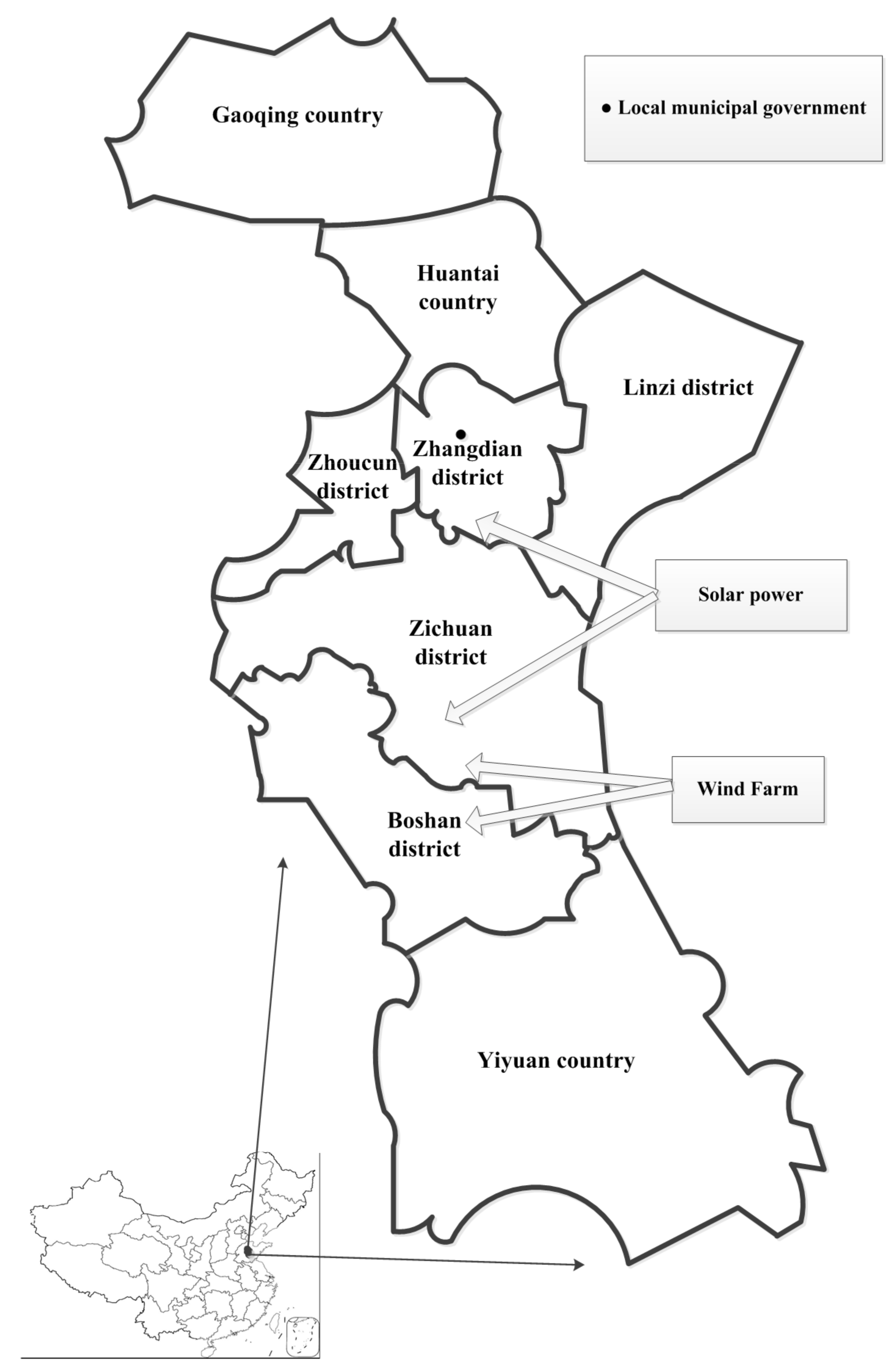
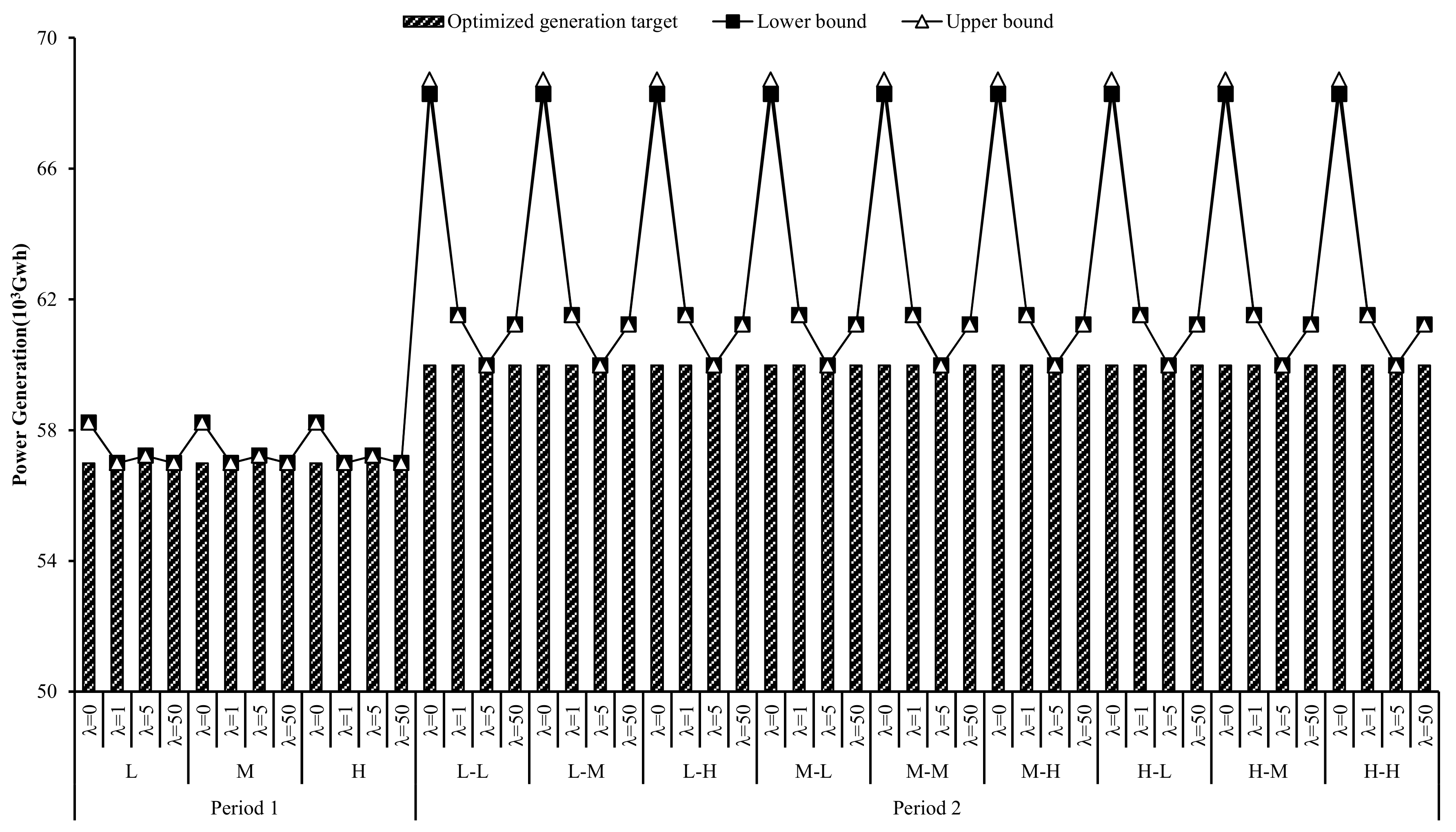
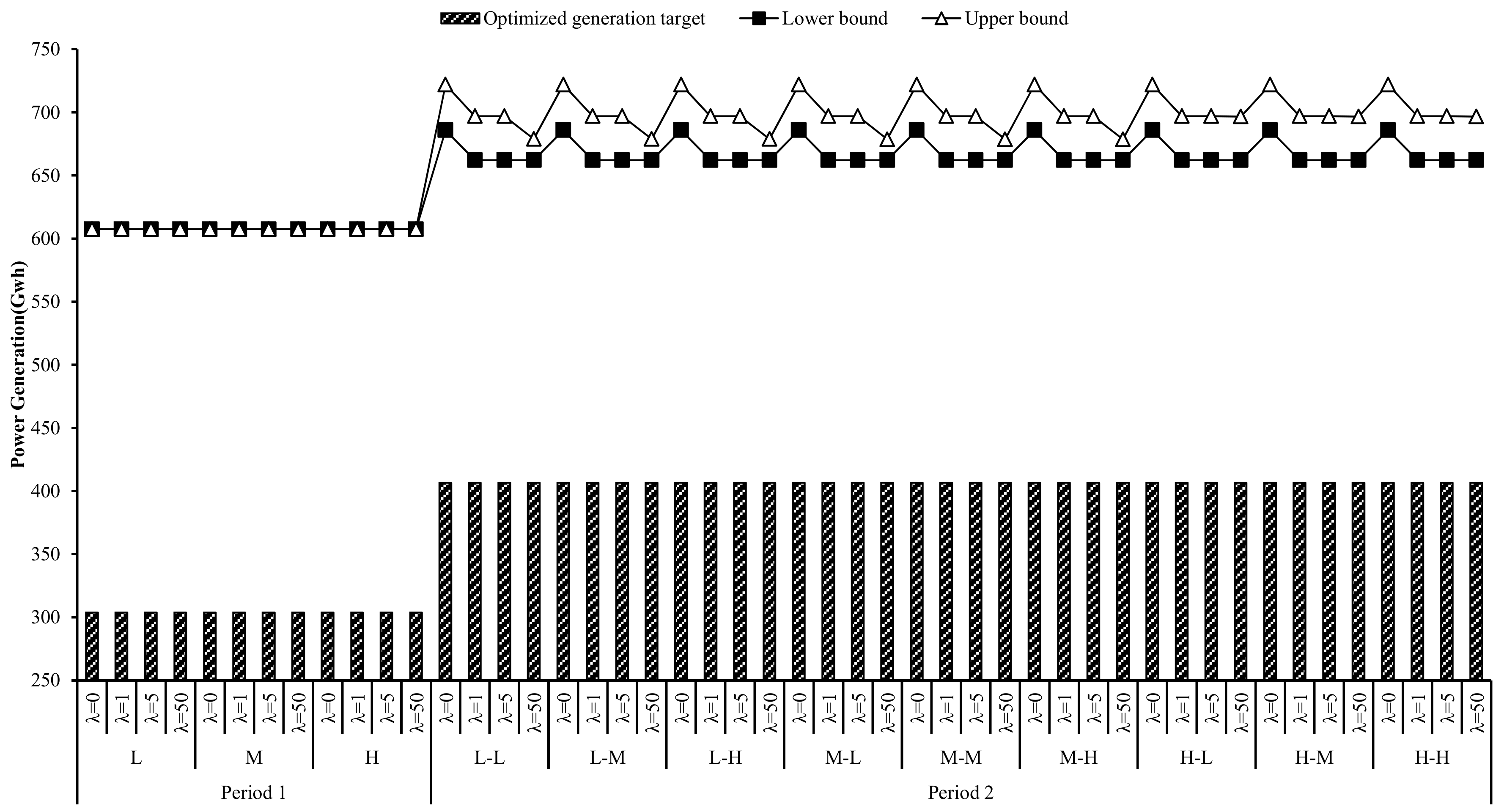
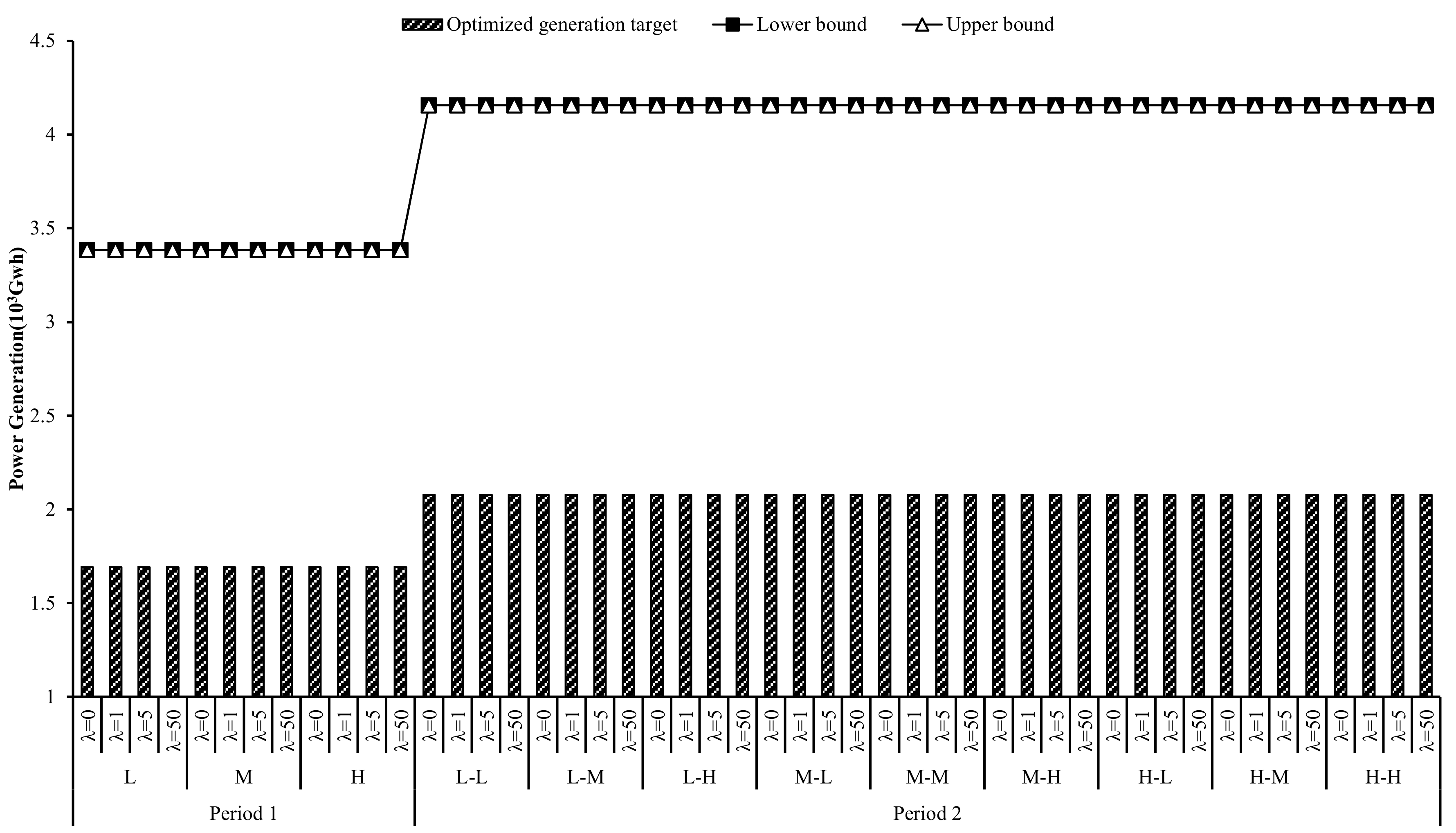
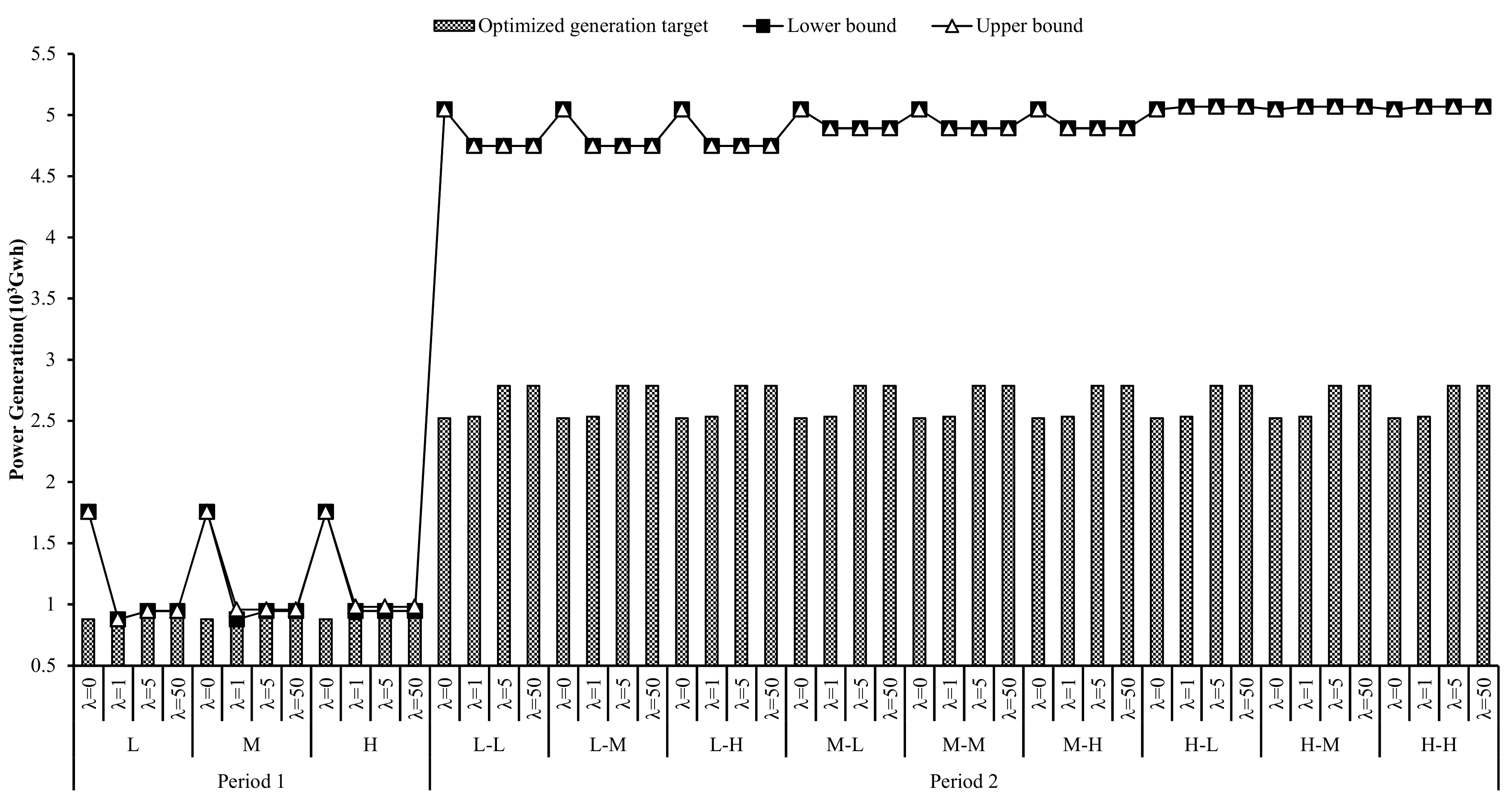
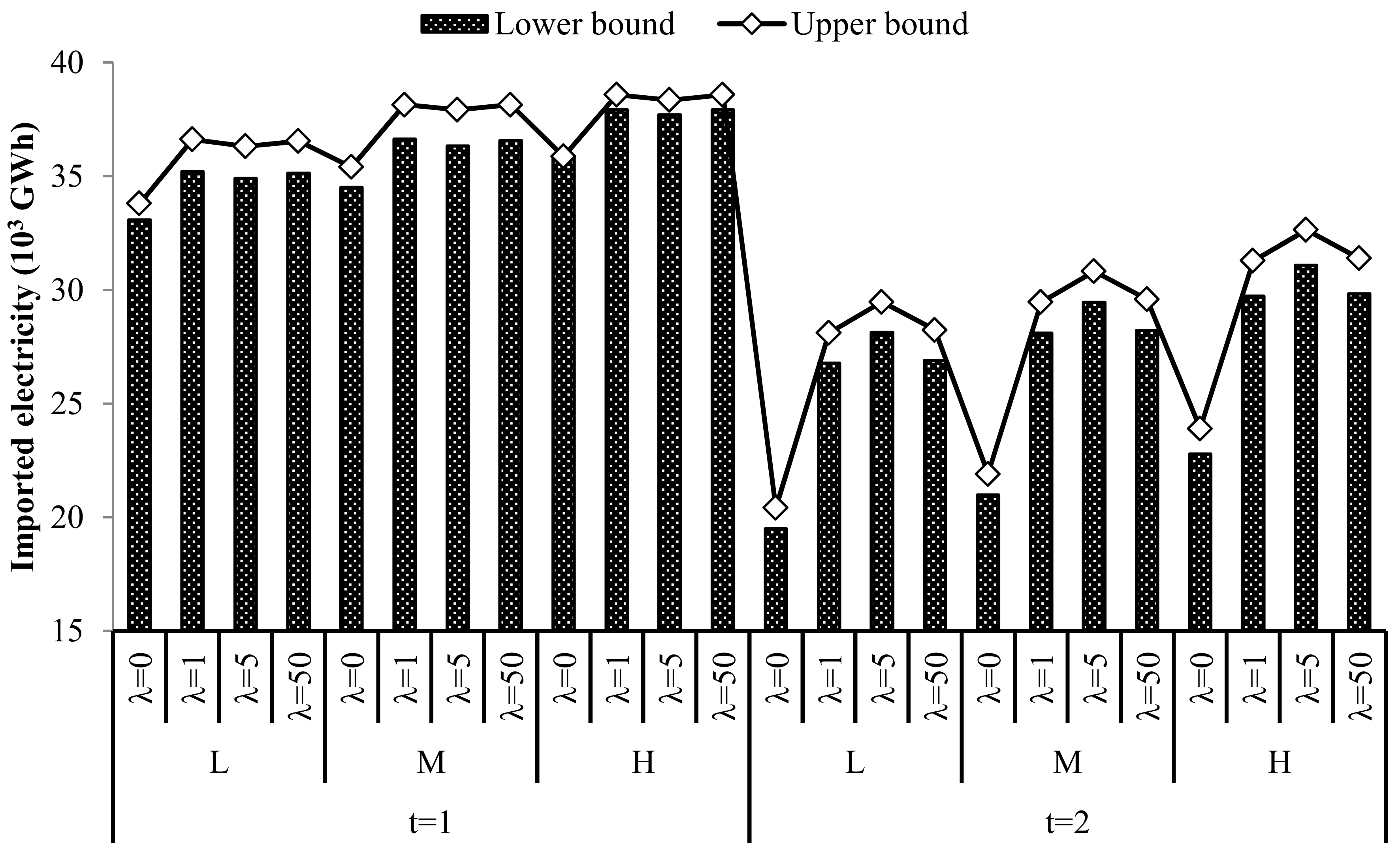
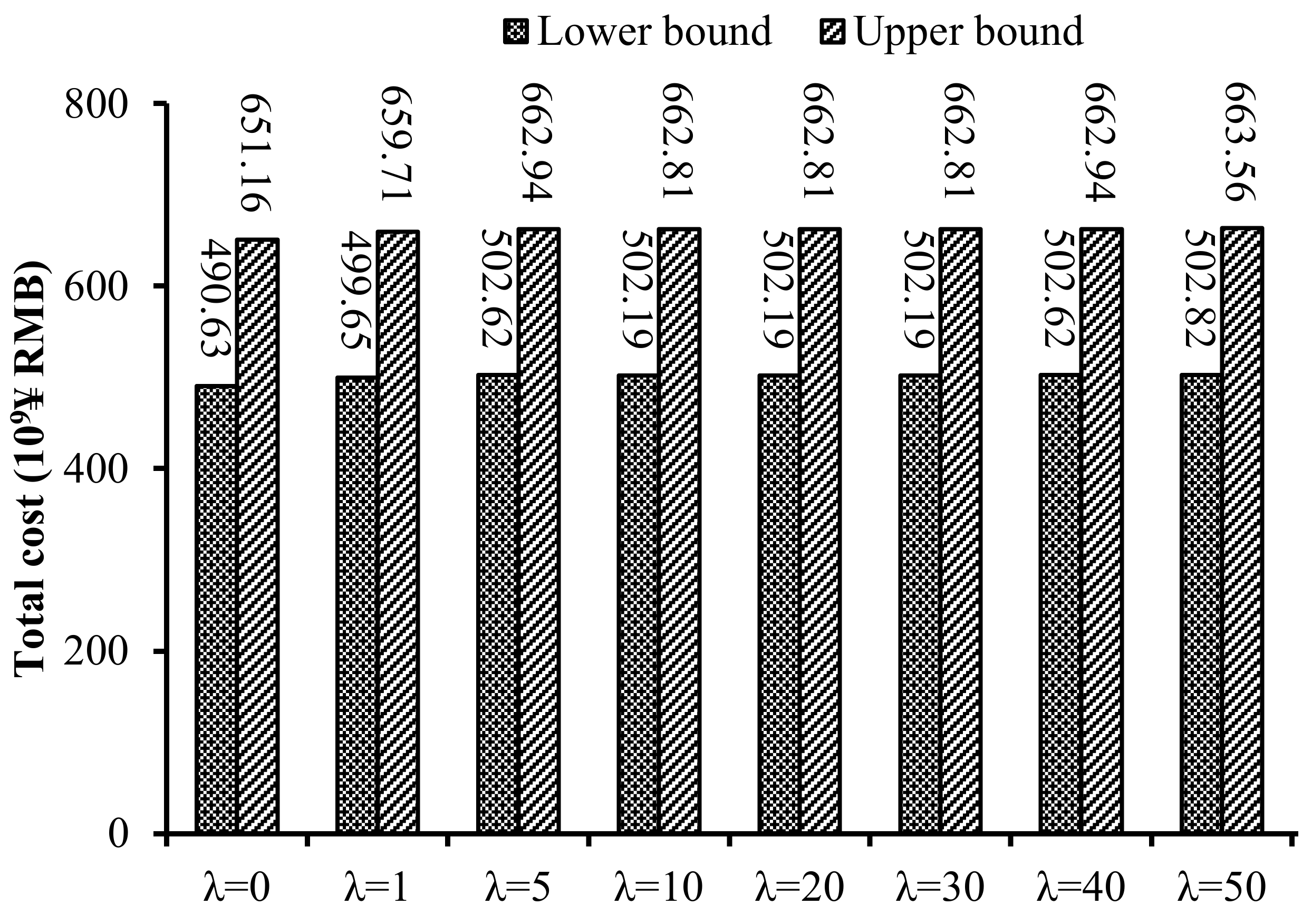
| Energy Demand | Demand Level | Probability (%) | T = 1 | T = 2 |
|---|---|---|---|---|
| Electricity demand (103 GWh) | Low | 20 | [97.11, 98.53] | [97.73, 99.11] |
| Medium | 60 | [98.53, 100.14] | [99.21, 100.60] | |
| High | 20 | [99.90, 100.60] | [101.00, 102.60] | |
| District heat quantity (PJ) | Low | 20 | [253.59, 259.59] | [255.00, 263.00] |
| Medium | 60 | [278.68, 288.68] | [285.00, 293.00] | |
| High | 20 | [288.87, 297.87] | [295.00, 302.00] |
| Technology | Level | Probability (%) | Optimized Generation Target (GWh) | Optimized Shortage Quantity (GWh) | Optimized Generation Quantity (GWh) |
|---|---|---|---|---|---|
| CHP | L | 25 | 56,989.23 | 1240.12 | 58,229.35 |
| M | 55 | 56,989.23 | 1240.12 | 58,229.35 | |
| H | 20 | 56,989.23 | 1240.12 | 58,229.35 | |
| L-L | 6.25 | 59,978.03 | [8302.54, 8737.05] | [68,280.57, 68,715.08] | |
| L-M | 13.75 | 59,978.03 | [8302.54, 8737.05] | [68,280.57, 68,715.08] | |
| L-H | 5 | 59,978.03 | [8302.54, 8737.05] | [68,280.57, 68,715.08] | |
| M-L | 13.75 | 59,978.03 | [8302.54, 8737.05] | [68,280.57, 68,715.08] | |
| M-M | 30.25 | 59,978.03 | [8302.54, 8737.05] | [68,280.57, 68,715.08] | |
| M-H | 11 | 59,978.03 | [8302.54, 8737.05] | [68,280.57, 68,715.08] | |
| H-L | 5 | 59,978.03 | [8302.54, 8737.05] | [68,280.57, 68,715.08] | |
| H-M | 11 | 59,978.03 | [8302.54, 8737.05] | [68,280.57, 68,715.08] | |
| H-H | 4 | 59,978.03 | [8302.54, 8737.05] | [68,280.57, 68,715.08] | |
| Hydropower | L | 25 | 29.01 | 29.01 | 58.02 |
| M | 55 | 29.01 | 29.01 | 58.02 | |
| H | 20 | 29.01 | 29.01 | 58.02 | |
| L-L | 6.25 | 30.85 | 30.85 | 61.70 | |
| L-M | 13.75 | 30.85 | 30.85 | 61.70 | |
| L-H | 5 | 30.85 | 30.85 | 61.70 | |
| M-L | 13.75 | 30.85 | 30.85 | 61.70 | |
| M-M | 30.25 | 30.85 | 30.85 | 61.70 | |
| M-H | 11 | 30.85 | 30.85 | 61.70 | |
| H-L | 5 | 30.85 | 30.85 | 61.70 | |
| H-M | 11 | 30.85 | 30.85 | 61.70 | |
| H-H | 4 | 30.85 | 30.85 | 61.70 | |
| Solar power | L | 25 | 303.74 | 303.74 | 607.48 |
| M | 55 | 303.74 | 303.74 | 607.48 | |
| H | 20 | 303.74 | 303.74 | 607.48 | |
| L-L | 6.25 | 406.53 | [279.34, 315.44] | [685.87, 721.97] | |
| L-M | 13.75 | 406.53 | [279.34, 315.44] | [685.87, 721.97] | |
| L-H | 5 | 406.53 | [279.34, 315.44] | [685.87, 721.97] | |
| M-L | 13.75 | 406.53 | [279.34, 315.44] | [685.87, 721.97] | |
| M-M | 30.25 | 406.53 | [279.34, 315.44] | [685.87, 721.97] | |
| M-H | 11 | 406.53 | [279.34, 315.44] | [685.87, 721.97] | |
| H-L | 5 | 406.53 | [279.34, 315.44] | [685.87, 721.97] | |
| H-M | 11 | 406.53 | [279.34, 315.44] | [685.87, 721.97] | |
| H-H | 4 | 406.53 | [279.34, 315.44] | [685.87, 721.97] | |
| Wind power | L | 25 | 1691.76 | 1691.76 | 3383.52 |
| M | 55 | 1691.76 | 1691.76 | 3383.52 | |
| H | 20 | 1691.76 | 1691.76 | 3383.52 | |
| L-L | 6.25 | 2077.83 | 2077.83 | 4155.66 | |
| L-M | 13.75 | 2077.83 | 2077.83 | 4155.66 | |
| L-H | 5 | 2077.83 | 2077.83 | 4155.66 | |
| M-L | 13.75 | 2077.83 | 2077.83 | 4155.66 | |
| M-M | 30.25 | 2077.83 | 2077.83 | 4155.66 | |
| M-H | 11 | 2077.83 | 2077.83 | 4155.66 | |
| H-L | 5 | 2077.83 | 2077.83 | 4155.66 | |
| H-M | 11 | 2077.83 | 2077.83 | 4155.66 | |
| H-H | 4 | 2077.83 | 2077.83 | 4155.66 | |
| Biomass and garbage power | L | 25 | 877.53 | 877.53 | 1755.06 |
| M | 55 | 877.53 | 877.53 | 1755.06 | |
| H | 20 | 877.53 | 877.53 | 1755.06 | |
| L-L | 6.25 | 2522.63 | 2522.63 | 5045.26 | |
| L-M | 13.75 | 2522.63 | 2522.63 | 5045.26 | |
| L-H | 5 | 2522.63 | 2522.63 | 5045.26 | |
| M-L | 13.75 | 2522.63 | 2522.63 | 5045.26 | |
| M-M | 30.25 | 2522.63 | 2522.63 | 5045.26 | |
| M-H | 11 | 2522.63 | 2522.63 | 5045.26 | |
| H-L | 5 | 2522.63 | 2522.63 | 5045.26 | |
| H-M | 11 | 2522.63 | 2522.63 | 5045.26 | |
| H-H | 4 | 2522.63 | 2522.63 | 5045.26 |
| Technology | Level | Probability (%) | Optimized Generation Target (GWh) | Optimized Shortage Quantity (GWh) | Optimized Generation Quantity (GWh) |
|---|---|---|---|---|---|
| CHP | L | 25 | 56,989.23 | 0 | 56,989.23 |
| M | 55 | 56,989.23 | 0 | 56,989.23 | |
| H | 20 | 56,989.23 | 0 | 56,989.23 | |
| L-L | 6.25 | 59,978.03 | 1536.75 | 61,514.78 | |
| L-M | 13.75 | 59,978.03 | 1536.75 | 61,514.78 | |
| L-H | 5 | 59,978.03 | 1536.75 | 61,514.78 | |
| M-L | 13.75 | 59,978.03 | 1536.75 | 61,514.78 | |
| M-M | 30.25 | 59,978.03 | 1536.75 | 61,514.78 | |
| M-H | 11 | 59,978.03 | 1536.75 | 61,514.78 | |
| H-L | 5 | 59,978.03 | 1536.75 | 61,514.78 | |
| H-M | 11 | 59,978.03 | 1536.75 | 61,514.78 | |
| H-H | 4 | 59,978.03 | 1536.75 | 61,514.78 | |
| Hydropower | L | 25 | 29.01 | 29.01 | 58.02 |
| M | 55 | 29.01 | 29.01 | 58.02 | |
| H | 20 | 29.01 | 29.01 | 58.02 | |
| L-L | 6.25 | 30.85 | 30.85 | 61.70 | |
| L-M | 13.75 | 30.85 | 30.85 | 61.70 | |
| L-H | 5 | 30.85 | 30.85 | 61.70 | |
| M-L | 13.75 | 30.85 | 30.85 | 61.70 | |
| M-M | 30.25 | 30.85 | 30.85 | 61.70 | |
| M-H | 11 | 30.85 | 30.85 | 61.70 | |
| H-L | 5 | 30.85 | 30.85 | 61.70 | |
| H-M | 11 | 30.85 | 30.85 | 61.70 | |
| H-H | 4 | 30.85 | 30.85 | 61.70 | |
| Solar power | L | 25 | 303.74 | 303.74 | 607.48 |
| M | 55 | 303.74 | 303.74 | 607.48 | |
| H | 20 | 303.74 | 303.74 | 607.48 | |
| L-L | 6.25 | 406.53 | [255.63, 290.48] | [662.16, 697.01] | |
| L-M | 13.75 | 406.53 | [255.63, 290.48] | [662.16, 697.01] | |
| L-H | 5 | 406.53 | [255.63, 290.48] | [662.16, 697.01] | |
| M-L | 13.75 | 406.53 | [255.63, 290.48] | [662.16, 697.01] | |
| M-M | 30.25 | 406.53 | [255.63, 290.48] | [662.16, 697.01] | |
| M-H | 11 | 406.53 | [255.63, 290.48] | [662.16, 697.01] | |
| H-L | 5 | 406.53 | [255.63, 290.48] | [662.16, 697.01] | |
| H-M | 11 | 406.53 | [255.63, 290.48] | [662.16, 697.01] | |
| H-H | 4 | 406.53 | [255.63, 290.48] | [662.16, 697.01] | |
| Wind power | L | 25 | 1691.76 | 1691.76 | 3383.52 |
| M | 55 | 1691.76 | 1691.76 | 3383.52 | |
| H | 20 | 1691.76 | 1691.76 | 3383.52 | |
| L-L | 6.25 | 2077.83 | 2077.83 | 4155.66 | |
| L-M | 13.75 | 2077.83 | 2077.83 | 4155.66 | |
| L-H | 5 | 2077.83 | 2077.83 | 4155.66 | |
| M-L | 13.75 | 2077.83 | 2077.83 | 4155.66 | |
| M-M | 30.25 | 2077.83 | 2077.83 | 4155.66 | |
| M-H | 11 | 2077.83 | 2077.83 | 4155.66 | |
| H-L | 5 | 2077.83 | 2077.83 | 4155.66 | |
| H-M | 11 | 2077.83 | 2077.83 | 4155.66 | |
| H-H | 4 | 2077.83 | 2077.83 | 4155.66 | |
| Biomass and garbage power | L | 25 | 877.53 | 0 | 877.53 |
| M | 55 | 877.53 | [0, 80.6] | [877.53, 958.13] | |
| H | 20 | 877.53 | [68.45, 103.45] | [945.98, 980.98] | |
| L-L | 6.25 | 2534.49 | 2212.79 | 4747.28 | |
| L-M | 13.75 | 2534.49 | 2212.79 | 4747.28 | |
| L-H | 5 | 2534.49 | 2212.79 | 4747.28 | |
| M-L | 13.75 | 2534.49 | 2357.88 | 4892.37 | |
| M-M | 30.25 | 2534.49 | 2357.88 | 4892.37 | |
| M-H | 11 | 2534.49 | 2357.88 | 4892.37 | |
| H-L | 5 | 2534.49 | 2534.49 | 5068.98 | |
| H-M | 11 | 2534.49 | 2534.49 | 5068.98 | |
| H-H | 4 | 2534.49 | 2534.49 | 5068.98 |
| Technology | Level | Probability (%) | Optimized Generation Target (GWh) | Optimized Shortage Quantity (GWh) | Optimized Generation Quantity (GWh) |
|---|---|---|---|---|---|
| CHP | L | 25 | 56,989.23 | 226.47 | 57,215.70 |
| M | 55 | 56,989.23 | 226.47 | 57,215.70 | |
| H | 20 | 56,989.23 | 226.47 | 57,215.70 | |
| L-L | 6.25 | 59,978.03 | 0 | 59,978.03 | |
| L-M | 13.75 | 59,978.03 | 0 | 59,978.03 | |
| L-H | 5 | 59,978.03 | 0 | 59,978.03 | |
| M-L | 13.75 | 59,978.03 | 0 | 59,978.03 | |
| M-M | 30.25 | 59,978.03 | 0 | 59,978.03 | |
| M-H | 11 | 59,978.03 | 0 | 59,978.03 | |
| H-L | 5 | 59,978.03 | 0 | 59,978.03 | |
| H-M | 11 | 59,978.03 | 0 | 59,978.03 | |
| H-H | 4 | 59,978.03 | 0 | 59,978.03 | |
| Hydropower | L | 25 | 29.01 | 29.01 | 58.02 |
| M | 55 | 29.01 | 29.01 | 58.02 | |
| H | 20 | 29.01 | 29.01 | 58.02 | |
| L-L | 6.25 | 30.85 | 30.85 | 61.70 | |
| L-M | 13.75 | 30.85 | 30.85 | 61.70 | |
| L-H | 5 | 30.85 | 30.85 | 61.70 | |
| M-L | 13.75 | 30.85 | 30.85 | 61.70 | |
| M-M | 30.25 | 30.85 | 30.85 | 61.70 | |
| M-H | 11 | 30.85 | 30.85 | 61.70 | |
| H-L | 5 | 30.85 | 30.85 | 61.70 | |
| H-M | 11 | 30.85 | 30.85 | 61.70 | |
| H-H | 4 | 30.85 | 30.85 | 61.70 | |
| Solar power | L | 25 | 303.74 | 303.74 | 607.48 |
| M | 55 | 303.74 | 303.74 | 607.48 | |
| H | 20 | 303.74 | 303.74 | 607.48 | |
| L-L | 6.25 | 406.53 | [255.63, 290.48] | [662.16, 697.01] | |
| L-M | 13.75 | 406.53 | [255.63, 290.48] | [662.16, 697.01] | |
| L-H | 5 | 406.53 | [255.63, 290.48] | [662.16, 697.01] | |
| M-L | 13.75 | 406.53 | [255.63, 290.48] | [662.16, 697.01] | |
| M-M | 30.25 | 406.53 | [255.63, 290.48] | [662.16, 697.01] | |
| M-H | 11 | 406.53 | [255.63, 290.48] | [662.16, 697.01] | |
| H-L | 5 | 406.53 | [255.63, 290.48] | [662.16, 697.01] | |
| H-M | 11 | 406.53 | [255.63, 290.48] | [662.16, 697.01] | |
| H-H | 4 | 406.53 | [255.63, 290.48] | [662.16, 697.01] | |
| Wind power | L | 25 | 1691.76 | 1691.76 | 3383.52 |
| M | 55 | 1691.76 | 1691.76 | 3383.52 | |
| H | 20 | 1691.76 | 1691.76 | 3383.52 | |
| L-L | 6.25 | 2077.83 | 2077.83 | 4155.66 | |
| L-M | 13.75 | 2077.83 | 2077.83 | 4155.66 | |
| L-H | 5 | 2077.83 | 2077.83 | 4155.66 | |
| M-L | 13.75 | 2077.83 | 2077.83 | 4155.66 | |
| M-M | 30.25 | 2077.83 | 2077.83 | 4155.66 | |
| M-H | 11 | 2077.83 | 2077.83 | 4155.66 | |
| H-L | 5 | 2077.83 | 2077.83 | 4155.66 | |
| H-M | 11 | 2077.83 | 2077.83 | 4155.66 | |
| H-H | 4 | 2077.83 | 2077.83 | 4155.66 | |
| Biomass and garbage power | L | 25 | 945.98 | 0 | 945.98 |
| M | 55 | 945.98 | [0, 12.15] | [945.98, 958.13] | |
| H | 20 | 945.98 | [0, 35] | [945.98, 980.98] | |
| L-L | 6.25 | 2787.65 | 1959.62 | 4747.27 | |
| L-M | 13.75 | 2787.65 | 1959.62 | 4747.27 | |
| L-H | 5 | 2787.65 | 1959.62 | 4747.27 | |
| M-L | 13.75 | 2787.65 | 2104.72 | 4892.37 | |
| M-M | 30.25 | 2787.65 | 2104.72 | 4892.37 | |
| M-H | 11 | 2787.65 | 2104.72 | 4892.37 | |
| H-L | 5 | 2787.65 | 2281.33 | 5068.98 | |
| H-M | 11 | 2787.65 | 2281.33 | 5068.98 | |
| H-H | 4 | 2787.65 | 2281.33 | 5068.98 |
| Technology | Level | Probability (%) | Optimized Generation Target (GWh) | Optimized Shortage Quantity (GWh) | Optimized Generation Quantity (GWh) |
|---|---|---|---|---|---|
| CHP | L | 25 | 56,989.23 | 0 | 56,989.23 |
| M | 55 | 56,989.23 | 0 | 56,989.23 | |
| H | 20 | 56,989.23 | 0 | 56,989.23 | |
| L-L | 6.25 | 59,978.03 | 1244.54 | 61,222.57 | |
| L-M | 13.75 | 59,978.03 | 1244.54 | 61,222.57 | |
| L-H | 5 | 59,978.03 | 1244.54 | 61,222.57 | |
| M-L | 13.75 | 59,978.03 | 1244.54 | 61,222.57 | |
| M-M | 30.25 | 59,978.03 | 1244.54 | 61,222.57 | |
| M-H | 11 | 59,978.03 | 1244.54 | 61,222.57 | |
| H-L | 5 | 59,978.03 | 1244.54 | 61,222.57 | |
| H-M | 11 | 59,978.03 | 1244.54 | 61,222.57 | |
| H-H | 4 | 59,978.03 | 1244.54 | 61,222.57 | |
| Hydropower | L | 25 | 29.01 | 29.01 | 58.02 |
| M | 55 | 29.01 | 29.01 | 58.02 | |
| H | 20 | 29.01 | 29.01 | 58.02 | |
| L-L | 6.25 | 30.85 | 30.85 | 61.70 | |
| L-M | 13.75 | 30.85 | 30.85 | 61.70 | |
| L-H | 5 | 30.85 | 30.85 | 61.70 | |
| M-L | 13.75 | 30.85 | 30.85 | 61.70 | |
| M-M | 30.25 | 30.85 | 30.85 | 61.70 | |
| M-H | 11 | 30.85 | 30.85 | 61.70 | |
| H-L | 5 | 30.85 | 30.85 | 61.70 | |
| H-M | 11 | 30.85 | 30.85 | 61.70 | |
| H-H | 4 | 30.85 | 30.85 | 61.70 | |
| Solar power | L | 25 | 303.74 | 303.74 | 607.48 |
| M | 55 | 303.74 | 303.74 | 607.48 | |
| H | 20 | 303.74 | 303.74 | 607.48 | |
| L-L | 6.25 | 406.53 | [255.63, 272.34] | [662.16, 678.87] | |
| L-M | 13.75 | 406.53 | [255.63, 272.34] | [662.16, 678.87] | |
| L-H | 5 | 406.53 | [255.63, 272.34] | [662.16, 678.87] | |
| M-L | 13.75 | 406.53 | [255.63, 272.12] | [662.16, 678.65] | |
| M-M | 30.25 | 406.53 | [255.63, 272.12] | [662.16, 678.65] | |
| M-H | 11 | 406.53 | [255.63, 272.12] | [662.16, 678.65] | |
| H-L | 5 | 406.53 | [255.63, 290.11] | [662.16, 696.64] | |
| H-M | 11 | 406.53 | [255.63, 290.11] | [662.16, 696.64] | |
| H-H | 4 | 406.53 | [255.63, 290.11] | [662.16, 696.64] | |
| Wind power | L | 25 | 1691.76 | 1691.76 | 3383.52 |
| M | 55 | 1691.76 | 1691.76 | 3383.52 | |
| H | 20 | 1691.76 | 1691.76 | 3383.52 | |
| L-L | 6.25 | 2077.83 | 2077.83 | 4155.66 | |
| L-M | 13.75 | 2077.83 | 2077.83 | 4155.66 | |
| L-H | 5 | 2077.83 | 2077.83 | 4155.66 | |
| M-L | 13.75 | 2077.83 | 2077.83 | 4155.66 | |
| M-M | 30.25 | 2077.83 | 2077.83 | 4155.66 | |
| M-H | 11 | 2077.83 | 2077.83 | 4155.66 | |
| H-L | 5 | 2077.83 | 2077.83 | 4155.66 | |
| H-M | 11 | 2077.83 | 2077.83 | 4155.66 | |
| H-H | 4 | 2077.83 | 2077.83 | 4155.66 | |
| Biomass and garbage power | L | 25 | 945.98 | 0 | 945.98 |
| M | 55 | 945.98 | [0, 12.15] | [945.978, 958.13] | |
| H | 20 | 945.98 | [0, 35] | [945.978, 980.98] | |
| L-L | 6.25 | 2787.65 | 1959.62 | 4747.27 | |
| L-M | 13.75 | 2787.65 | 1959.62 | 4747.27 | |
| L-H | 5 | 2787.65 | 1959.62 | 4747.27 | |
| M-L | 13.75 | 2787.65 | 2104.72 | 4892.37 | |
| M-M | 30.25 | 2787.65 | 2104.72 | 4892.37 | |
| M-H | 11 | 2787.65 | 2104.72 | 4892.37 | |
| H-L | 5 | 2787.65 | 2281.33 | 5068.98 | |
| H-M | 11 | 2787.65 | 2281.33 | 5068.98 | |
| H-H | 4 | 2787.65 | 2281.33 | 5068.98 |
| Gaseous Emission | λ Level | T = 1 | T = 2 |
|---|---|---|---|
| CO2 (106 ton) | λ= 0 | [61.88, 63.11] | [63.07, 64.10] |
| λ = 1 | [60.3, 60.77] | [56.82, 57.40] | |
| Λ = 5 | [60.54, 61.01] | [55.60, 56.17] | |
| λ = 50 | [60.31, 60.77] | [56.72, 57.30] | |
| SO2 (103 ton) | λ = 0 | [70.35, 82.75] | [51.58, 76.43] |
| λ = 1 | [68.76, 79.91] | [46.37, 68.28] | |
| λ = 5 | [69.03, 80.23] | [45.35, 66.78] | |
| λ = 50 | [68.76, 79.91] | [46.28, 68.16] | |
| NOx (103 ton) | λ = 0 | [60.36, 86.29] | [40.51, 81.00] |
| λ = 1 | [59.04, 83.38] | [36.41, 72.34] | |
| λ = 5 | [59.27, 83.71] | [35.61, 70.75] | |
| λ = 50 | [59.03, 83.38] | [36.35, 72.21] | |
| PM (103 ton) | λ = 0 | [9.74, 12.82] | [5.57, 8.04] |
| λ = 1 | [9.53, 12.38] | [5.00, 7.18] | |
| λ = 5 | [9.56, 12.43] | [4.89, 7.02] | |
| λ = 50 | [9.52, 12.38] | [5.00, 7.17] |
© 2018 by the authors. Licensee MDPI, Basel, Switzerland. This article is an open access article distributed under the terms and conditions of the Creative Commons Attribution (CC BY) license (http://creativecommons.org/licenses/by/4.0/).
Share and Cite
Xie, Y.; Wang, L.; Huang, G.; Xia, D.; Ji, L. A Stochastic Inexact Robust Model for Regional Energy System Management and Emission Reduction Potential Analysis—A Case Study of Zibo City, China. Energies 2018, 11, 2108. https://doi.org/10.3390/en11082108
Xie Y, Wang L, Huang G, Xia D, Ji L. A Stochastic Inexact Robust Model for Regional Energy System Management and Emission Reduction Potential Analysis—A Case Study of Zibo City, China. Energies. 2018; 11(8):2108. https://doi.org/10.3390/en11082108
Chicago/Turabian StyleXie, Yulei, Linrui Wang, Guohe Huang, Dehong Xia, and Ling Ji. 2018. "A Stochastic Inexact Robust Model for Regional Energy System Management and Emission Reduction Potential Analysis—A Case Study of Zibo City, China" Energies 11, no. 8: 2108. https://doi.org/10.3390/en11082108
APA StyleXie, Y., Wang, L., Huang, G., Xia, D., & Ji, L. (2018). A Stochastic Inexact Robust Model for Regional Energy System Management and Emission Reduction Potential Analysis—A Case Study of Zibo City, China. Energies, 11(8), 2108. https://doi.org/10.3390/en11082108






